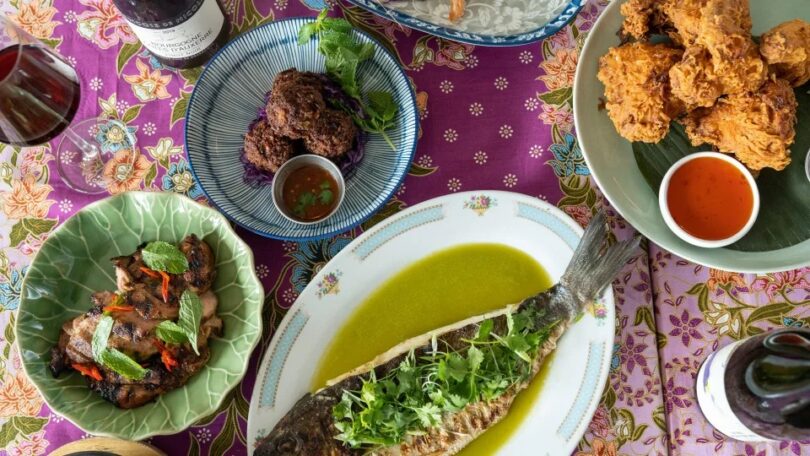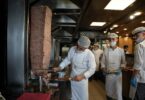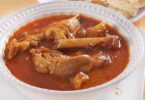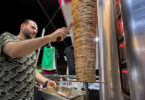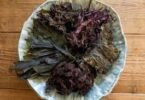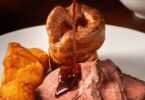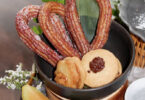(CNN): When Anajak Thai opened in 1981, most people who walked into the Los Angeles restaurant weren’t familiar with Thai cuisine. They just thought it was spicy Chinese food, said Justin Pichetrungsi, the restaurant’s current head chef and owner.
The Sherman Oaks eatery, started by Pichetrungsi’s father Rick Pichetrungsi, was one of the first Thai restaurants in L.A., according to Pichetrungsi. The restaurant’s original, multi-page menu in the ‘80s listed around 60 dishes — among them pad thai, pad see-ew and panang curry — that introduced American diners to the flavors of Thailand while remaining approachable.
Forty years later, Anajak — and Thai food in the US — has come a long way.
“Our diasporic cuisine became part of the rotation of American takeout,” Pichetrungsi said.
Thai is now one of the nation’s most popular cuisines, with more than 10,000 restaurants in the US despite Thai people making up about 0.1% of the nation’s overall population. Still, Thai food has struggled to shed a reputation of being cheap takeout fare — something that Pichetrungsi has been trying to change since 2019, when he left his job as an art director at Disney to take over Anajak full time. Over the last few years, he’s overhauled the menu and transformed Anajak into a culinary hotspot.
Anajak’s evolution from a hole-in-the-wall joint to foodie favorite has been a decades-long process. It’s also, in some ways, the story of Thai food in the US.
How Thai food came to the US
To understand how Thai restaurants became so widespread in the US, you have to go back to US intervention in southeast Asia during the Cold War, said Mark Padoongpatt, an associate professor of Asian American studies at the University of Nevada, Las Vegas, and the author of “Flavors of Empire: Food and the Making of Thai America.”
The US established a strategic relationship with Thailand in the 1960s as it sought to prevent the spread of communism in the region. An expanded American footprint in the country meant that ordinary Americans were able to travel to Thailand and experience its food, which set the stage for the eventual interest in Thai cuisine back home, Padoongpatt said. In one example detailed in his book, a White woman named Marie Wilson accompanied her husband on a stint in Thailand teaching English and published the cookbook “Siamese Cookery” upon her return.
“Food became the place where a lot of Americans came to understand Thai people for the first time,” Padoongpatt said. “So when (Thai people) come to the United States, they then have to navigate their identity in relation to food.”
Thai people started immigrating to the US in the late ‘60s and ‘70s. Many of them were on student visas that restricted their employment options and ended up finding work in restaurant kitchens and other food businesses, according to Padoongpatt.

One such immigrant was Pichetrungsi’s father. Rick Pichetrungsi, born in Thailand to a Cantonese family, came to the US at 18 and spent more than a decade working in various Los Angeles restaurants before deciding to start his own, Pichetrungsi said. Anajak Thai, like other Thai restaurants of the era, primarily served the stir-fries and curries of Central Thailand, along with Chinese dishes like wonton soup to entice less adventurous customers.
Despite the seemingly standard fare, running a Thai restaurant at the time required a degree of creativity and inventiveness. Many key Thai ingredients weren’t readily available in the US, and chefs had to make substitutions that altered the intended flavors of certain dishes. In making the northeastern Thai dipping sauce nam jim, for example, Pichetrungsi said his father used jalapeno in place of Thai chilis and white sugar instead of palm sugar.
“A lot of those flavors were somewhat more assimilated flavors,” Pichetrungsi said. “They were him trying to find the analogue of this or that or this in order to make that flavor for himself.”
Some chefs tried to move beyond pad thai
Over the next several decades, Anajak Thai became a homey neighborhood go-to with a loyal customer base. Other Thai immigrants opened up similar restaurants across the country, cementing the cuisine’s foothold in the US.
Thai food became so popular among Americans that the Thai government took notice. In the early 2000s, it launched a program that would train Thai chefs and send them abroad to open Thai restaurants, with the aim of encouraging tourism to Thailand, Padoongpatt said. As part of that campaign, the government also attempted to standardize Thai restaurants and their menus, in hopes of making dishes like pad thai as synonymous with Thai culture as say, the Big Mac is with McDonald’s.
Even as the Thai government tried to standardize restaurant fare, some Thai restaurateurs were beginning to venture outside of what most Americans had come to associate with Thai food. In 1999, for instance, now famed chef Saipin Chutima and her husband Bill opened Lotus of Siam in Las Vegas, introducing diners to the northern Thai recipes that were in her family for generations.
Another effort at diversifying Thai cuisine in the US came from Andy Ricker, the founder and chef behind the now closed restaurant group Pok Pok. Ricker, a White American who traveled and lived in Thailand on and off for decades, told CNN he opened Pok Pok in Portland, Oregon, in 2005 after not being able to find the food he ate in Chiang Mai and Bangkok at US restaurants. His venture rose to prominence serving regional staples like kai yaang and khao soi, expanding to locations in other cities before Ricker closed shop in 2020.
Padoongpatt, who considers the chef a friend, credits Ricker with pushing regional Thai cuisine and Thai street food forward in the US and opening up the market for a new generation of Thai American chefs. But he notes that Thai immigrants didn’t necessarily lack imagination — rather, they had to consider how serving dishes that were unfamiliar to most Americans might affect business.
“I think it tells you something about race and food in America — that it took someone like Andy Ricker to break that door open,” Padoongpatt said.

But there were also plenty of Thai chefs who also stretched that boundary. In 2011, Chiang Mai native Hong Thaimee opened Ngam (later renamed Thaimee Table) in New York’s East Village, which she characterized as “modern Thai comfort food.” Rather than serving customers exactly the kind of Thai food she ate growing up, she stayed true to classic Thai flavor combinations while adapting certain dishes for a Western palate.
“If I put sai-ua (northern Thai sausage) on the menu, it might be too early or too soon,” Thaimee, who is working on an upcoming Thai food podcast called “Sabai Talk,” said. “But I made that in the form of a Thai burger, and it was a hit.”
While the Thai restaurant scene was starting to shift in the mid-to-late 2000s, some chefs still felt like they had to tread with caution.
Food writer and cookbook author Leela Punyaratabandhu recalls how Thai restaurants in Chicago back then had secret menus that Thai customers and more adventurous American eaters could order from. Those secret menus featured bolder, lesser-known dishes that those working in the back of the restaurant would be more inclined to eat. Over time, as Americans became more knowledgeable about other cuisines, they started paying more attention to the secret menu offerings, emboldening Thai chefs to serve the kind of food they wanted.
“Fast forward 20 some years, the secret menus are the regular menus now,” said Punyaratabandhu, author of “Bangkok: Recipes and Stories from the Heart of Thailand” and the newsletter The Epestle.
Thai food in the US reaches new heights
Today, the Thai restaurant scene in the US is perhaps the most exciting that it’s ever been.
More and more restaurants are catering to specific, regional Thai cuisines, be it the spicy and pungent flavors of Isan in the northeast or the Malaysian- and Indonesian-influenced curries of the south. And Thai American chefs like Pichetrungsi are continuing to defy stereotypes and misconceptions of what constitutes Thai food. On the menu on one recent evening in July were dishes such as southern Thai fried chicken and haw mok, a steamed fish curry custard.
“We’ve gone beyond what the common staples within our cuisine are, like pad thai and pad see ew,” Pichetrungsi said. “People are really diving a lot deeper.”
In addition to its rotating, seasonal dinner menu, Anajak under Pichetrungsi boasts Thai Taco Tuesdays and monthly Thai omakase meals — changes that have earned critical acclaim. The Los Angeles Times named Anajak restaurant of the year in 2022, and Pichetrungsi recently won a James Beard Award for best chef in California.

Still, given the Covid-19 pandemic’s serious toll on the restaurant industry, Pichetrungsi feels like he has to strike a delicate balance. He wants to show diners just how innovative Thai cuisine can be, but he’s hesitant to take familiar comforts like pad thai off the menu altogether. “Pad thai pays for the party,” he added.
Diners might not be ready to part with pad thai, but Pichetrungsi hopes that restaurants like Anajak will help them see Thai food anew — and maybe even try something different.
“I hope that people realize that Thai food is something as worthwhile and as eventful and as night out-worthy as any other cuisine,” Pichetrungsi said. “You can get dressed, listen to a bunch of live music and buy a really baller bottle of champagne while eating some really humble, rustic food.”

